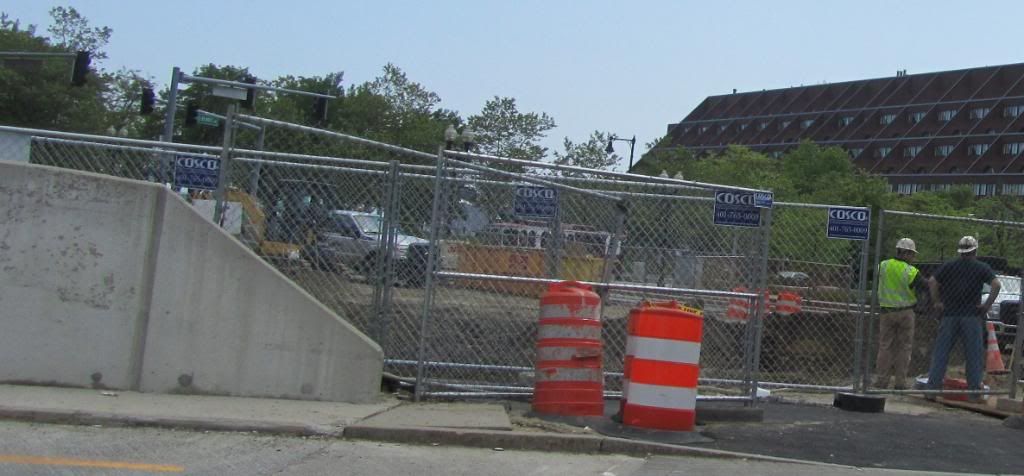Boston Harbor Islands Pavilion celebrates grand opening on greenway
Sending your articleYour article has been sent.
(Jeremy C. Fox for Boston.com)
Mayor Thomas M. Menino joined with other city and state officials, members of the Boston Harbor Islands Alliance, park rangers and dozens of community members on Thursday to celebrate the grand opening of the Boston Harbor Islands Pavilion.
By Jeremy C. Fox, Town Correspondent
On Thursday, Mayor Thomas M. Menino claimed a victory for improvements on the Rose Fitzgerald Kennedy Greenway as he presided at the grand opening celebration for the Boston Harbor Islands Pavilion.
With four major building projects for the greenway scrapped in the past three years and some critics saying the city and the conservancy that oversees the string of parks had failed to make it an active urban green space, Menino came out swinging.
?A lot of folks write a lot of stories about the greenway ? nobody uses it; it?s a barren wasteland,? Menino said. ?But did anybody come down here this weekend and see how many thousands of people were on the greenway??
With his characteristic pugnacious humor, Menino said critics of the greenway return to the suburbs on the weekend and miss out on the real popularity of the parks. ?This place is a beehive of activity. It?s a new great place to come in the summer months, fall and spring,? the mayor said.
Douglas M. McGarrah, chair of the Boston Harbor Island Alliance?s board, had some fun with the supposed impossibility of building on the greenway as well. He opened the ceremony with a list of the legislation and approvals necessary for the pavilion to be built: an act of the US Congress, an act of the Massachusetts legislature, approval of the Federal Highway Administration and other ?federal bureaucracies,? the approval of the state Executive Office of Energy and Environmental Affairs, as well as the approval of the Boston Redevelopment Authority and other city agencies.
Amid the humor, though, the celebration was touched with somberness. Two of the planned speakers ? Governor Deval Patrick and Energy and Environmental Affairs Secretary Rick Sullivan ? were unable to attend because they were surveying the destruction in Western Massachusetts wrought by Wednesday?s tornados that killed four people.
Located on the Rose Fitzgerald Kennedy Greenway between Faneuil Hall Marketplace and Long Wharf, the pavilion marks a victory as well for the federal, state and nonprofit partners that oversee the islands: the National Park Service, the Massachusetts Department of Conservation and Recreation and the Boston Harbor Island Alliance. The new pavilion will serve as a gateway to the islands, offering maps, information, ferry tickets and island-related merchandise.
Powered by solar panels atop its concrete canopies, the pavilion is a ?zero net energy? structure that also captures rain to water the surrounding plantings. It was designed by architects from the downtown firm Utile Inc. in collaboration with the landscape architecture firm Reed Hilderbrand and the design and consulting firm IDEO.
Two of the 34 islands ? Georges Island and Spectacle Island ? are accessible by ferry from Long Wharf, just across Atlantic Avenue from the new pavilion, while ferries to other islands leave from South Boston, Hingham, Hull and Quincy. The 39-acre Georges Island is the site of Fort Warren, built to defend Boston Harbor after the War of 1812 and used as a military training camp and as a Civil War prison. Spectacle Island was used by the City of Boston as a landfill until 1959 and rehabilitated in recent years using clay and sediment from the Big Dig.
Thursday?s speakers credited the late US Senator Edward M. Kennedy and US Congressman Michael E. Capuano with securing $5 million from the National Park Service that provided the bulk of the approximately $6 million for the construction of the pavilion.
Kennedy?s widow, Victoria Reggie Kennedy, reminisced on Thursday about her husband?s love of the outdoors and the ocean and his particular fondness of the Boston Harbor Islands.
?How Teddy would have loved this day, how he looked forward to this day,? she said. She said Kennedy?s mother, born near the pavilion site in the North End?s Garden Court, taught her children that every child should have access to the outdoors and to look out to sea.
?And every day of her life ? and I mean this, rain or shine, until the last of her 104 and a half years ? Rose Fitzgerald Kennedy was outside breathing in the fresh air,? Reggie Kennedy said. ?Her baby boy Edward Kennedy was the same way.?
?I think we toured just about every national park in Massachusetts on our family history trips, but the Boston Harbor Islands tour was a unique and special time, because he loved the sea,? she said. ?And how he would love this magnificent pavilion. ??
http://www.boston.com/yourtown/news...ton_harbor_islands_pavilion.html?comments=all
